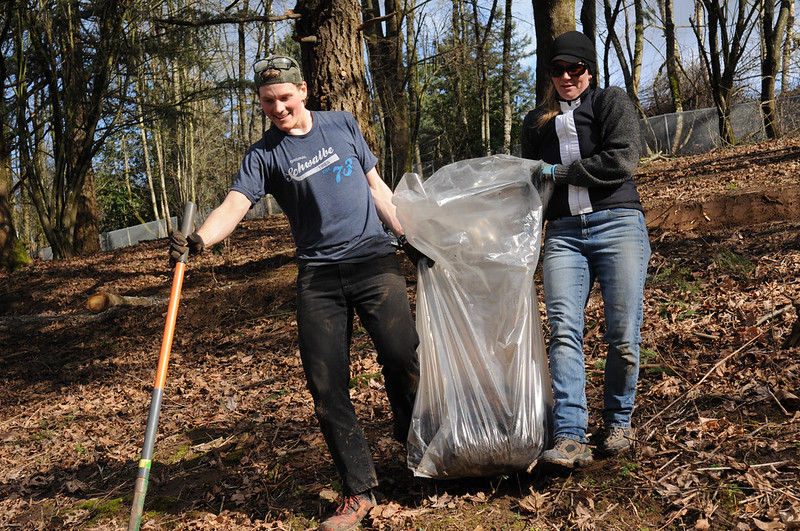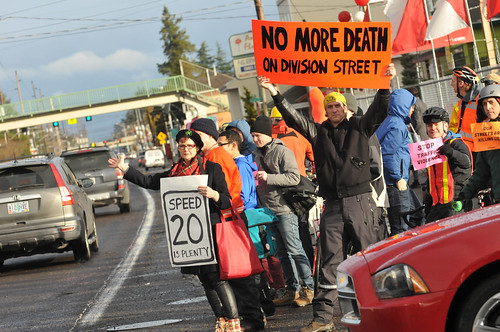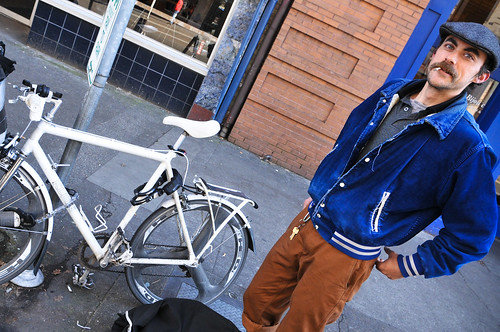Sorry, this job has been filled. Browse more great jobs here.
Year: 2017
Weekend Event Guide: Showers Pass sale, trail work, Crusade finale, and more

What’s on your list this weekend? The weather looks a bit iffy, but you never know how it’ll end up so you might as well plan to ride.
If the national news has dampened your mood, let me make two suggestions: Evalyn Parry’s SPIN, a show about the bicycle’s impact on women; and the two trail work days on Saturday where you can do something to improve your community. And please support the Showers Pass Warehouse Sale on Saturday. They advertised it with us and we’re grateful for their business!
Check out our selections below. And don’t forget to check the full calendar for the latest updates…
Portland Art Museum to unveil new plans for Rothko Pavillion expansion

After it faced stiff opposition at a City Council hearing in April, the Portland Art Museum has revised plans for their $50 million Rothko Pavillion expansion.
Seven months later they’re ready to share a new one.
At issue is how the plans will impact Madision Plaza, a public easement between existing museum buildings. Madison Plaza is considered an important link in downtown bicycling and walking connectivity.
Earlier this year, PAM asked the City of Portland to amend the existing easement for SW Madison Street between Park and 10th. Initial plans for the new pavillion would have created a new structure to display art, host events, and serve as the museum’s main entrance. The pavillion would be open to the public for free, but access would be limited to museum hours (10:00 am to 5:00 pm Sunday through Wednesday and 10:00 to 8:00 pm Thursday and Friday) and people riding bicycles or walking dogs would be completely prohibited.
That plan proved highly controversial. Following a large outcry from nearby residents and other people who use the plaza, PAM put the plans on hold.
One year after we mourned Mitch York on the St. Johns Bridge, another person has died at the same intersection

A 71-year-old man died Saturday night while driving on the St. Johns Bridge. Keizer resident John Crook was the 41st person to die on Portland roads this year (we had 35 deaths at this time last year).
Crook’s death comes one year after hundreds of Portlanders biked onto the bridge and held a vigil for Mitch York, who was killed by a reckless driver at the same intersection.
In Saturday’s collision, police say Crook was driving a Kia Optima westbound on the bridge “at a high rate of speed” and failed to stop for the red light at Bridge Avenue. Crook ran into someone driving a Ford F-150. The impact from the collision was so powerful that the truck — at nearly twice the size of the small Kia — flipped over and landed off the roadway on its roof. The two people inside the truck sustained what police call “non life-threatening injuries” (a term that bothers me, because it glosses over what could be horrific, life-altering injuries).
This crash underscores that the design of the St. Johns Bridge, that advocates have been concerned about for many years, is unsafe for everyone. People drive dangerously on the bridge in part because the design lets them. The Oregon Department of Transportation, who ignored recommendations (from the City of Portland, advocates, Metro, and engineering consultants) for a safer cross-section in 2005, has kept the bridge as a four-lane thoroughfare. The wide-open design gives drivers a false sense of security and encourages dangerous behaviors that put human lives at risk.
Meet the BikeCrafters: Makeshifter Canvas Works, Velo Gioielli, and Filmed by Bike
In case you haven’t heard, Portland’s bike-centric holiday gift fair is back! BikeCraft 2017 is December 15-17 at the Bike Farm (1810 NE 1st Ave.)
This year our friends (and BikeCraft veterans) at Microcosm Publishing have taken over the reins and it’s sure to be one of the best ever.
A look at opposition to street updates on Lincoln and Willamette

If your understanding of Portland is only through Portlandia episodes or the glowing, brochure-like visions shared in magazines and conference presentations, you might think we ride everywhere on perfect paths while passersby wave at us benevolently.
As real as it may seem, that happens only my dreams (thanks Debbie Gibson).
PBOT changing Outer Division plans amid parking and freight access concerns

“Outer SE Division is really a mess.”
“Across the board we have overall support. But we’re also hearing, ‘Wow, losing on-street parking will be a big deal for our business,’ and, ‘How’s freight going to work?'”
— Liz Mahon, PBOT
That’s how Portland Bureau of Transportation Project Manager Liz Mahon introduced this project at a joint meeting of the City’s bicycle and pedestrian advisory committees last month. And she’s right. That slide above showing data from five years of crashes between SE 122nd and 126th is just one piece of evidence in the case against Division.
That’s why the City of Portland’s Outer Division Multimodal Safety Project is such a big deal. In addition to this being arguably the most dangerous road in Portland, the project is something of a test for the Bureau of Transportation. Can they match vision zero rhetoric with real, on-the-ground, infrastructure? Can they prove to east Portlanders that their pleas for safety are being heard? Can they do it on a faster-than-usual timeline? And most importantly, can they respond to concerns from businesses without overly compromising the outcomes of the project?
So far things have gone well. Following a high-profile kickoff meeting back in February, PBOT took the unprecedented step of declaring an official city emergency to reduce the speed limit on Division. Now they’re working through a plan that will include dozens of “enhanced crossings,” speed cameras, new and improved sidewalks, protected bike lanes, and a raised center median.
Space for that center median and protected bikeway has to come from somewhere. And that’s where things are getting sticky.


“National surveys show that medians reduce accidents but also may hurt auto-reliant businesses. Division is lined with auto-reliant businesses.”
— Division Midway Alliance
PBOT’s initial plan was to use the space currently used to park cars on the street. While this project has broad support from many in the adjacent community who’ve been clamoring for safety improvements for years, business owners have voiced concerns about the loss of on-street parking and impacts to freight delivery.
“Across the board we have overall support,” Mahon said at the advisory committee meeting last month, “But we’re also hearing, ‘Wow, losing on-street parking will be a big deal for our business,’ and, ‘How’s freight going to work?'”
Now Mahon and PBOT are revising the plans to see where they can, “Create opportunities for on-street parking to come back” while making freight truck access work better.
PBOT has heard directly from the Division Midway Alliance, a nonprofit that represents business owners between 117th to 148th avenues. The DMA feels that the median and parking removal will hurt local businesses. “National surveys show that medians reduce accidents but also may hurt auto-reliant businesses. Division is lined with auto-reliant businesses,” says a notice posted on the DMA website today. Here’s more from that posting:
Advertisement
At a meeting late last month, business owners, some who said they felt left out, “steamrolled” in the words of one, of the planning process, told PBOT and other officials their concerns and views, including:
– Medians will cut their business because potential customers, diverted by the medians, will not bother to turn in;
– Delivery trucks will have difficulty making turns or finding alternate routes;
– Drivers will seek other routes, too, pushing traffic on to already overtaxed surface and neighborhood streets;
– Wouldn’t more police enforcement – ALONE – of speed limits and jaywalking reduce accidents?
– And why not fix the roadway, add streetlights and fill in the sidewalks first and NOW?
It’s worth noting that PBOT has been up front from Day One about how this project would impact the street. The official project website has this list of “tradeoffs” that are required to make Division safe:
– Safety improvements may require removing parking on both sides of the street. Instead of parking cars on Division Street, people may need to park cars on side streets or private property.
– People may need to use a different driveway when driving to or from a location directly on Division Street.
– People driving may need to turn off or onto Division at different locations, because a center median will help people turn at the safest spots.
– PBOT will work through these tradeoffs with the community through 2017.
Reached for comment today, PBOT confirmed that business owners in the Jade District are also worried about parking loss. “We believe we can accommodate some on-street parking with separated bike lanes,” PBOT’s Dylan Rivera said via email today. “And we are working with business owners on design options.”

Rivera said the larger challenge is the freight access issue. Namely, how truck operators can still service businesses without a center turn lane to stop in, and with a curbside lane that will be reserved for bicycling and separated from other lanes with vertical plastic wands (side streets aren’t big enough for large trucks, and residents don’t want them there even if they did).
To make this work, Rivera says PBOT is, “Exploring tools that will provide a protected bike lane while not precluding freight.” The solution could mean a raised — yet mountable — barrier to protect the bike lane which they say would keep cars out but still allow trucks to use the bike lane. Since they’d be in the path of bicycle riders, PBOT might restrict loading and unloading to “certain low-traffic hours of the day.” That idea was quickly questioned by committee member Doug Klotz. “I think it’d be better if trucks stopped in the right hand auto lane,” he said. “That seems to be what vision zero would call for.”
Another issue that came up at the October Bicycle Advisory Committee meeting is how u-turning drivers might encroach on biking space at corners. PBOT says they’re aware of that issue and will plan on using special markings to warn users of the hazard. Some committee members recommended that PBOT prohibit u-turns by large trucks and instead require them to circle the block. Others questioned why PBOT would design a project with danger spots built in: “I don’t want you to introduce untested facilities with obvious conflict points as part of a safety improvement,” said Elliot Akwai-Scott.
To learn more about this project and see PBOT’s latest plans, attend the open house this Thursday (11/9) from 5:00 to 7:00 pm at Portland Community College Hall Annex (2305 SE 82nd Ave).
— Jonathan Maus: (503) 706-8804, @jonathan_maus on Twitter and jonathan@bikeportland.org
Never miss a story. Sign-up for the daily BP Headlines email.
BikePortland needs your support.
Lo and behold: An American city just focused their “be seen” message on drivers

I’m sure your inbox and timelines are full of well-meaning organizations urging you to “be safe and be seen” this time of year.
These are important messages, but it’s annoying how they usually focus on vulnerable road users. It makes sense intuitively, but that paternalistic approach fails to address the elephant in the room — or should I say the huge, powerful steel vehicles in our streets.
“Dress up like a traffic cone if you want to survive winter!” these campaigns too often say.
That’s why I was very pleased to see the latest statement from the Portland Bureau of Transportation. “‘Be Seen. Be Safe.’ Traffic safety during the darker days of the year,” the headline reads.
The full text is below. Notice how the focus — first and foremost — is on people who drive cars and trucks (after a solid first sentence that’s generalized to all road users):
Inspiring speeches from Oregon Walks award winners

(Photo: Steph Routh)
As I alluded to last week, volunteer activism is at the foundation of Portland’s livable streets movement. At Oregon Walks‘ annual Weston Awards fundraising party on Friday night, two of the award winners epitomized that fact: citizen activist Steve Bozzone and the Brentwood Darlington Neighborhood represented by Meesa Long, Lesley McKinley and Chelsea Powers.
With an impressive crowd of advocates, electeds, city staffers, and fellow citizen activists looking on, Bozzone and McKinley shared memorable acceptance speeches that are worth sharing.
Long, McKinley and Powers were up first. This amazing trio led an effort that garnered over $5 million in grants to improve streets in their southeast Portland neighborhood. That’s a big number for a grassroots campaign! And in the process they set records for highest public participation Metro had ever seen by rallying their fellow residents to send in hundreds of postcards, fill in online comment forms, and sign petitions (over 1,000 signatures total).
The Monday Roundup: NYC aftermath, vision zero fire truck, Uber’s strange ad, and more
Here are the best stories that came across our desks last week:
Auto industry funds anti-walking propaganda: Treehugger breaks down how America’s “culture of fear” — filtered through an American Academy of Orthopaedic Surgeons PR campaign supported by auto manufactuers — is shifting blame for unsafe streets away from drivers and onto walkers.
Beer bikes banned: Amsterdam has outlawed those huge, pedal-powered “beer bikes” after many complaints of rowdy tourists made them a “nuisance”.
Residential bike parking: Portland’s ubiquitous blue bike staple racks rarely reach into residential areas. We need more places to park near homes. What to do? The Dutch use “bicycle hangars” and other neighborhood facilities.
Vision Zero fire truck: San Francisco officials purchased new fire engines with many features that aim to make them safer for use in dense urban areas where lots of people walk and bike.
Portland’s new era of transportation activism
People who use a busy section of Willamette Boulevard in North Portland will be safer by the end of this month (if all goes according to plan). It’s an improvement we waited seven years for and it happened in just a few days, all thanks to smart and quick action by handful of volunteers who care deeply about the safety of our streets.
The astounding speed of the progress we just witnessed on Willamette is just the latest in a string of successes that can be tied directly to the actions of Portland’s considerable army of unpaid transportation reform activists.
The lineage of this DIY activism is a proud tradition in Portland and goes back far beyond my time on this beat; but it seems to be gaining steam of late due to a variety of factors — all of which were present on the Willamette Blvd effort.
Friends and family launch fundraiser, will celebrate Boyd Littell’s life Sunday
An outpouring of heartfelt remembrances and grief have followed the untimely death of Boyd Littell (he was known as “Gee” by his family). Now his family and friends have come together to raise money for a funeral and burial in his hometown of Norman, Oklahoma.
Littell is the 40-year-old musician and professional courier who died early Tuesday morning. Police found him in Colonel Summers Park lying next to his bike with a wound on his head. The cause of his crash remains unknown.
According to a story in the Norman Transcript, Boyd moved to Portland in 2014. His passion was music and the hip-hop band he played drums in, ADDverse Affects, was on a skyward trajectory. After “taking Norman by storm,” Boyd and band co-founder Josh Azzam came to Portland to seek new musical horizons.
In the past few days I’ve heard from Josh and other people who were close to Boyd.

















